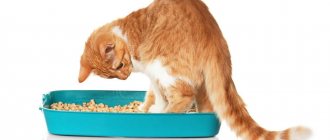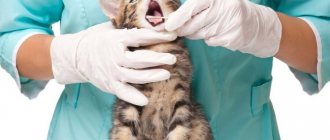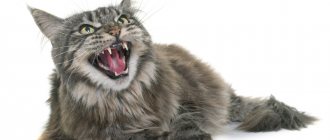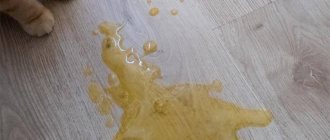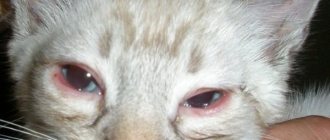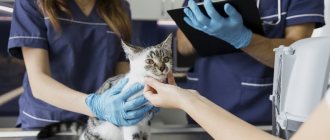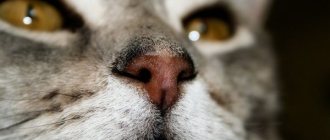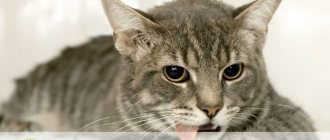Melena, a term used to describe black, tarry stool, is usually caused by bleeding in the upper part of the gastrointestinal tract. This is also seen in cats after they have ingested a sufficient amount of blood from the mouth or respiratory tract.
Black stool itself is not a disease, but a symptom of some other underlying disease. The dark color of blood occurs due to the oxidation of iron in hemoglobin (the oxygen that carries the pigment in red blood cells) as it passes through the small and large intestines.
Symptoms and types
Symptoms are related to the underlying cause and location of the bleeding.
In patients with gastrointestinal bleeding:
- Vomiting blood
- Lack of appetite
- Weight loss
- Weakness
- Pale mucous membranes
- Anemia
© shutterstock
In patients with airway bleeding :
- Nose bleed
- Sneezing
- Coughing up blood
- Anemia
- Pale mucous membranes
- Labored breathing
In patients with abnormal bleeding disorders:
- Nose bleed
- Blood in urine
- Anemia
- Blood in the eye (hyphema)
- Pale mucous membranes
Dangerous symptoms
A pet's health can be determined in part by its behavior. If a cat has black stool, but the pet is active and affectionate as usual, and willingly accepts play, most likely the cause of the change in stool is physiological factors. However, the presence of a number of symptoms against the background of black stool indicates serious problems and requires immediate medical consultation:
- Stool with blood clots. This is a clear sign of heavy internal bleeding. His life depends on the speed of helping the purr.
- Unusual pet behavior. If a cat meows pitifully and the scream intensifies when you try to touch his stomach, this indicates a pain syndrome. An additional sign of pain is a slight trembling throughout the animal’s body.
- Temperature increase.
- Vomiting and/or false urges.
- Weakness. A bad sign is the fluffy's apathy, when he shows no interest in what is happening and simply lies indifferently.
- Deterioration of appetite, complete refusal of food.
- Extreme thirst or refusal to drink water.
- Frequent urge to urinate.
- Pale gums.
- Formation of wounds and bruises on the body.
Loose, black stool is called melena and is a sign of heavy bleeding.
The animal may be prescribed IVs to replenish lost fluid.
Diagnostics
You will need to provide details about your cat's health, symptoms, and possible incidents that may have led to your cat's black poop. The history you provide can help your veterinarian understand where the blood is coming from. After taking a complete history, your pet's veterinarian will perform a complete physical examination. Standard laboratory tests include a complete blood count (CBC), chemistry profile, and urinalysis. The results of these tests will depend on the root cause of the problem.
A blood test may reveal anemia with red blood cells that are smaller (microcytic) and paler than normal (hypochromic). In cases of chronic blood loss, the anemia is usually non-regenerative, meaning the bone marrow does not respond normally to the body's increased need for red blood cells. In acute cases, anemia is most often regenerative in nature, since the bone marrow usually responds to the increased needs of the body by supplying new red blood cells.
Other abnormalities may include a decrease in the number of platelets (the cells responsible for blood clotting), an increase in the number of white blood cells called neutrophils (neutrophilia), and a decrease in the number of both red and white blood cells. A biochemical profile may reveal changes associated with disease states other than intestinal causes of melena, including the kidney and liver. A urine test can detect blood in the urine, which is commonly seen in patients with blood clotting defects.
An abdominal x-ray will be taken to look for any masses, foreign bodies that may have been swallowed, and abnormalities in the size and shape of the kidneys and/or liver. A chest x-ray will help identify lesions in the lungs and esophagus, which are also a relatively common underlying cause of black stool in cats.
Ultrasound is also used for internal imaging and often provides more detailed images of the abdomen and gastrointestinal tract. An ultrasound can detect tumors, liver disease, inflammation of the pancreas, or kidney disease. Another diagnostic tool your veterinarian will likely use is an endoscope, a flexible tube that is inserted into the stomach through the esophagus to directly visualize masses and/or ulcers in the esophagus, stomach and/or intestines. Endoscopy also helps take biopsy samples for tissue analysis and remove foreign bodies if present.
© shutterstock
Causes of changes in stool color
If changes appear in the cat's litter box, you need to analyze the pet's condition and diet. Black stools are not always a sign of illness.
Physiological reasons
There are a number of factors that change the color of stool, but do not pose a threat to the pet’s health:
- Iron. A trace element that enters the body as part of a supplement reacts with food and can change the color of intestinal masses. If the stool becomes colored, you should stop using the drug.
- Meat. If a cat has a heavy meal of raw meat or liver, this will certainly lead to darkening of the stool, since these products contain a lot of iron. If an animal eats raw meat on a regular basis, the stool will always be black. In addition, frequent consumption of raw meat increases the risk of infection with worms.
- Dyes, preparations with pigment. If a cat is given activated charcoal or eats cherries, the feces will darken.
- Changes in the color and consistency of your cat's stool can also be caused by stress.
Although the listed factors do not threaten the health of the purr, measures should be taken to prevent the situation from reoccurring. A diet based on raw meat, in addition to the risk of infection with helminths and microbes, is dangerous due to excess protein and lack of fiber.
Changes in your kitten's stool should be taken especially seriously. The weak body of a baby is more susceptible to diseases compared to adult cats.
Physiological reasons for changes in stool color
Pathological causes
There are a number of factors that cannot be ignored. Some of them, such as internal bleeding, can cost the fluffy his life.
Worm infestation
Parasites usually inhabit the small intestine. To get nutrition, they cling to the intestinal walls and disrupt the integrity of the internal mucous membrane. As a result, slight bleeding appears. Blood is digested along with food and colors the stool.
Hemorrhagic gastroenteritis
This inflammatory disease is characterized by detachment of capillaries and internal linings of the gastrointestinal tract, followed by bleeding. The causes of the pathology are:
- poor blood clotting;
- panleukopenia;
- stress;
- autoimmune disease;
- food intolerance.
Traumatic gastritis or colitis
The inner linings of the stomach and intestines are scratched by hard objects that enter the body. Cracks and ulcers form on the mucous membranes. The wounds bleed, and the blood that gets into the gastrointestinal tract changes the color of the stool.
Poor nutrition is the main cause of injury to internal organs
Ulcerative gastritis, ulcerative enterocolitis
An ulcer of any nature is a wound, only inside an organ. Every wound bleeds, especially if the pet receives food that is not suitable for its condition.
Tumors of the stomach and small intestine
During the formation and growth of a tumor, especially a malignant one, the mucous membranes of organs are destroyed, capillaries burst, and bleeding begins.
Postoperative hemorrhage
If your pet has undergone surgery, after which the animal's stool turns black, this may indicate bleeding from the internal sutures. Blue-black stool color is a sign of heavy blood loss.
Care
The main goal of therapy is to treat the underlying disease, including kidney, liver and lung diseases. Successful treatment should eventually resolve the black stool problem. Fluid therapy will be given to replenish fluid levels in the body, and whole blood transfusions may be required in some patients with severe blood loss and anemia. Patients who experience persistent vomiting will require medications to control the vomiting and allow them to hold onto food long enough to digest it. Severe ulcers or tumors in the gastrointestinal tract may require surgery.
Treatment of cats with black stools
The primary goal is to stop the bleeding.
The following drugs are used:
- Tranexam;
- Vikasol;
- Aminocaproic acid;
- Dicynone.
The next step is to eliminate the cause of the disease. If a tumor or foreign object is found in the intestine, surgery is performed.
If urgent deworming is necessary, anthelmintic drugs are prescribed.
When the infectious etiology of the disease is established, antiviral drugs, antibiotics, and immunomodulators are used.
For peptic ulcers, as well as gastroenteritis of non-contagious etiology, gastroprotectors are prescribed.
Life and management
The duration and type of treatment for your cat will depend on the underlying cause of the melena. Initially, daily blood testing may be required to assess your cat's ongoing anemia, which may evolve into weekly testing once your cat's health has stabilized. In cases with regular episodes of vomiting, it is necessary to maintain hydration to correct fluid deficiency. Monitor your cat for blood or color changes in its stool during treatment, and tell your veterinarian if anything seems unusual, including changes in behavior.
Most patients recover after treatment of the underlying disease. Because melena is just a symptom, the overall prognosis will depend on the diagnosis and treatment of the underlying disease or condition.
Black feces in a kitten
If an adult cat is sick, this is bad. But if a little kitten gets sick, it can end tragically for his life. The normal color of a kitten's stool should be brown. If the stool turns black, diarrhea with mucus or constipation appears, it means that the pet’s digestive system is not functioning well. The reason may be:
- stress;
- transition from cat milk to adult food;
- binge eating;
- allergic reaction to products;
- infectious diseases.
Accompanying signs: the kitten refuses to eat, its stomach is swollen, the stool contains mucus and blood, loose stools that have an unpleasant odor and are black.
How to accurately diagnose the disease
Only a veterinarian can identify the exact reason why a cat is bleeding profusely. The animal owner’s task is to help the specialist collect anamnesis. During the consultation you will have to answer the following questions:
- what does a pet eat?
- does he go outside?
- whether there are poisonous plants or other substances hazardous to health in the house that the cat could reach.
The veterinarian will ask how often your pet poops with blood in it and if there are any other warning signs. For example, constipation, diarrhea, poor appetite, depression. During the examination, the cat's temperature is taken.
To establish the exact cause of blood in the stool, additional research will be needed:
- analysis of stool, urine and blood (general, allergen and biochemical);
- Ultrasound of internal organs;
- X-ray of the intestine;
- colonoscopy;
- If tumors are detected, a biopsy will have to be done.
Treatment tactics depending on the cause of the symptom
When diagnosing stones or neoplasms in a cat, or detecting a foreign object, there is only one way out - surgical intervention. In other cases, the treatment plan is developed individually for each four-legged patient.
The primary task is to stop bleeding. Hemostatic drugs are administered intramuscularly or intravenously. As a rule, Tranexam, Vikasol, Dicynon, aminocaproic acid are prescribed. Information on standard drug treatment is presented in the table:
| Main disease | Group of drugs | Names of drugs |
| Worm infestation | Antiparasitic | Milbemax, Stronghold, Prasitel, Drontal, Dirofen |
| Sand in the gallbladder | Choleretic | Cholenzyme, Allochol, dehydrocholic acid |
| Inflammation | Antibiotics | Streptomycin, Erythromycin |
| Antiviral | Fosprenil, Anandin, Gamapren, Gamavit, Cycloferon | |
| Stomach lesions | Gastroprotectors | De-Nol, Maalox, Almagel, Ranitidine |
What might the stool of a sick animal look like?
In the tray of his pet, the owner may find feces that differ in shape:
- ointment-like;
- mushy;
- liquid;
- foamy;
- in the form of “goat peas”;
- in the form of a tape or pencil.
By smell they distinguish: sour, rancid, putrefactive.
- Feces acquire a sour smell when the absorption of fatty acids in the small intestine is disrupted or due to fermentation processes in the large intestine.
- An unpleasant odor, similar to the smell of bad oil, occurs when the secretory function of the pancreas is disrupted or when the flow of bile is disrupted.
- The smell of rotting occurs when digestion in the stomach is disrupted, dyspepsia develops with the proliferation of putrefactive microflora in the intestines. Or the cat suffers from colitis with ulcerations.
It is customary to distinguish feces by color:
- red (beetroot);
- black (tarry);
- dark brown;
- light brown;
- with a scarlet admixture (undigested blood);
- yellow;
- light yellow;
- greenish yellow;
- bleached slightly yellow, gray, gray-white.
A healthy cat can have red or beetroot feces if it has eaten beets or food colored with bright dyes. This coloring is not pathological and soon the stool acquires a normal color.
What treatment is prescribed?
Medication
Depending on the diagnosis, the veterinarian selects the most optimal treatment regimen, which often includes the following groups of drugs:
Dicynone is able to stop a minor source of bleeding in an animal.
- Hemostatic. If diagnostics show that the cat is developing internal bleeding, but it is not life-threatening, the doctor will prescribe medications that can prevent the loss of vital fluid. Effective drugs in this group: “Dicinon”;
- "Tranexam";
- "Vikasol".
- "Penicillin";
- "Interferon";
- "Pyrantel";
- "Maalox";
Surgical
Sometimes surgery is the only option for an animal to return to normal.
Sometimes it is impossible to normalize a pet’s condition with medications alone, for example, with heavy internal bleeding. To save the animal's life, the doctor decides to perform surgical treatment. The manipulations are performed under general anesthesia. After the operation, a long recovery will be required, during which it is important for the owner to control the diet of his four-legged friend, as well as give him medications prescribed by the doctor to prevent the development of inflammatory processes and increase the body's defenses.
What to do for prevention?
Preventive measures involve systematic treatment for worms.
Liquid or dry feces, which are constantly observed in a pet, in any case, are evidence of some kind of internal progressive disorder. To prevent consequences dangerous to the cat’s health and life, it is important to follow preventive rules. First of all, it is important to monitor the cat’s nutrition and provide it with fresh and clean water. Do not forget to carry out preventive anthelmintic treatment. If viral infectious diseases develop, do not self-medicate, but take the animal to a veterinarian, who, based on the diagnostic results, will select an effective treatment. In order for the cat’s body to more actively resist various diseases, it is useful to strengthen the pet’s immunity. To do this, it is recommended to give courses of vitamins and various biologically active supplements, which are selected by the veterinarian, taking into account the individual characteristics of the cat.
When a visit to the vet should not be postponed
Urgent veterinary care is needed for your pet when the following additional symptoms occur:
- stomach ache;
- plaintive meow;
- temperature above 40 °C;
- diarrhea;
- vomit;
- refusal to eat;
- blood clots in excrement.
Be sure to read:
A cat vomits hair: reasons, what to do, medications and folk remedies, prevention
The most dangerous sign is the appearance of melena - feces with a tarry consistency, indicating large-scale bleeding.
Price issue
Let's talk about the cost of the listed drugs. The same Prazitel is sold in veterinary pharmacies or hospitals. The price starts from 80 rubles per tablet or from 170 rubles per suspension.
“Drontal” in tablets will cost the animal owner 320-400 rubles, depending on the region of residence.
"Pratel" is a rather expensive drug. For ten tablets you will have to pay from 450 to 600 rubles.
"Dirofen" costs about 120-150 rubles.
The rest of the drugs are sold in regular, human pharmacies. Price categories are quite different, depending on the region where the pharmacy is located.

